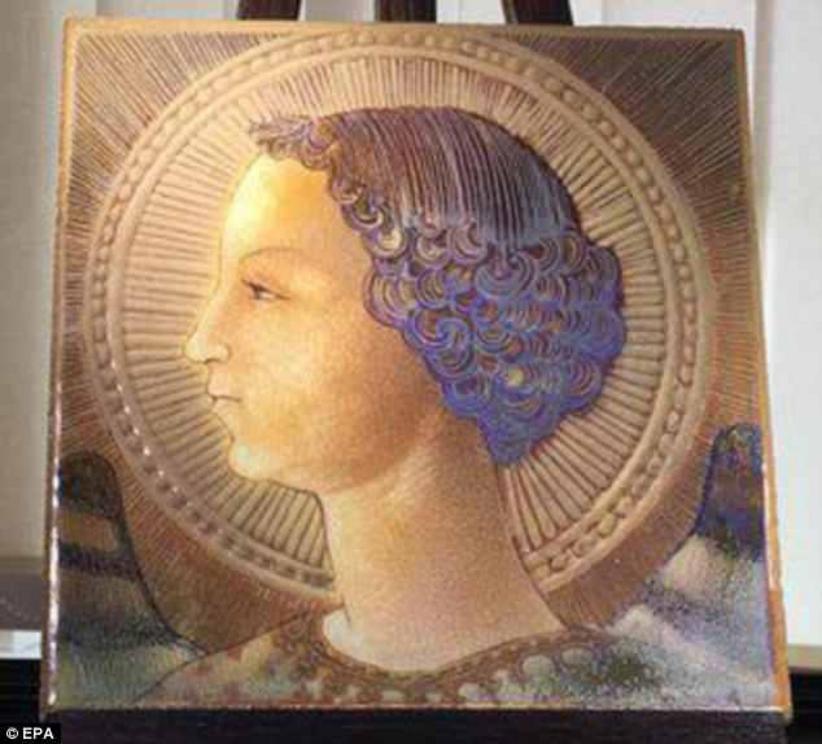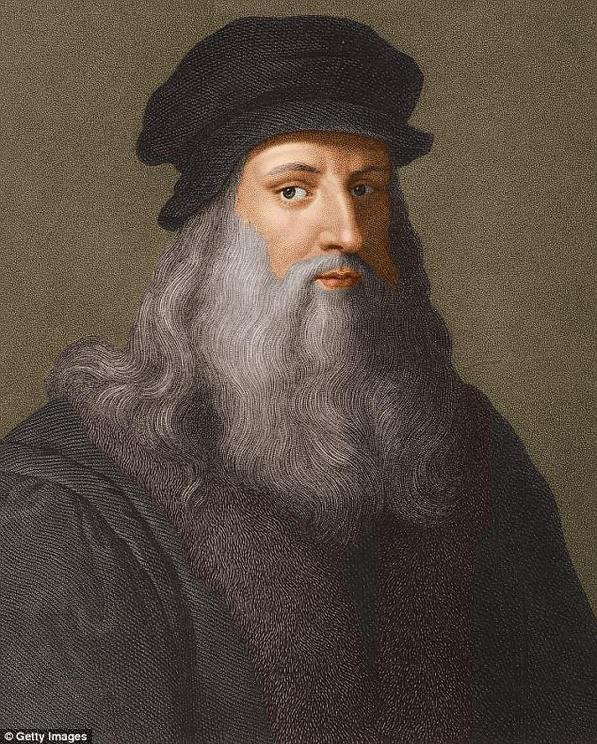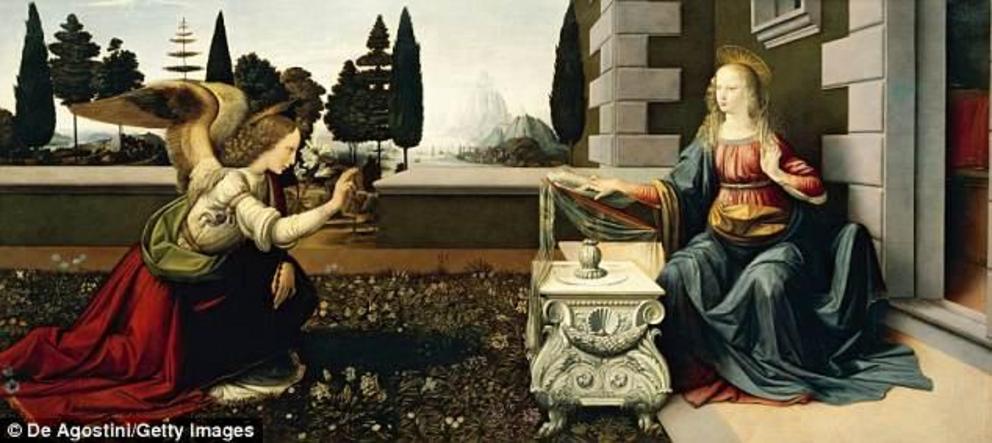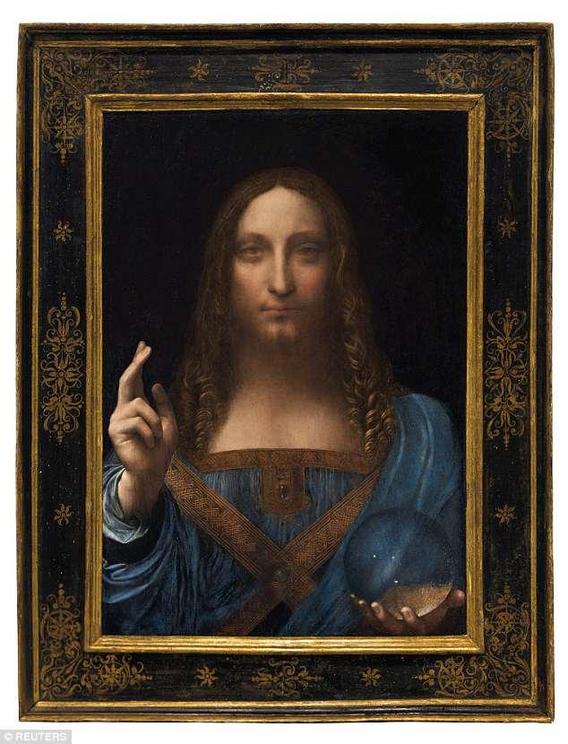Is this Leonardo da Vinci's earliest surviving work?
A tiny tile painting of an angel is tearing the art world apart after experts claim a detail unnoticed for 600 years proves it to be da Vinci's earliest creation.
While cleaning out their house, a family in Italy happened upon a glazed terracotta tile, showing a profile image of the Archangel Gabriel.

After three years of investigating, historians revealed the words 'da Vinci Leonardi' and the date '1471' in the angel's jawline.
They believe the painting - which would have been created when da Vinci was just 18 - could be his earliest known work of art.

A family in Italy discovered a small glazed tile that's believed to be the earliest known work by Renaissance genius Leonardo da Vinci. A signature in the painting's jawline is claimed as proof

Though some experts have clamoured to attribute the piece to da Vinci, another described the chances of it being by the artist as 'less than zero'
However, not everyone in the art world is buying it, including world renowned da Vinci expert Martin Kemp.
Many argue it is just the latest evidence of someone claiming to have discovered a new work by the Renaissance genius - something that happens almost every year, according to the Guardian.
'The chance of it being by Leonardo is less than zero,' Kemp, an emeritus professor of art history at Oxford University, told the Guardian. 'The silly season for Leonardo never closes.'
Kemp pointed to the work's 'vermicelli like' hair as a particularly unconvincing element of the portrait, noting that it compared 'poorly' to da Vinci's The Annunciation.
The painting, believed to have been made in 1472 or 1473, is currently regarded as da Vinci's earliest known work.
Still, art historian and expert Ernesto Solari, along with handwriting expert Ivana Rosa Bonfantino, say that infrared analysis confirms that it has ties to da Vinci.
Bontafino - who has analysed countless autographs by the artist - has argued that the smaller number one in the inscription is reminiscent of da Vinci's handwriting.

Skeptic and da Vinci expert Martin Kemp said some details in the tile compared 'poorly' to da Vinci's Annunciation (pictured), which is currently regarded as his earliest known work

Art historian and expert Ernesto Solari, along with handwriting expert Ivana Rosa Bonfantino, claim that years of analysis have confirmed that the tile is in fact da Vinci's earliest known work
'We have done everything humanly possible to verify its provenance,' Solari said, according to the Telegraph.
'Science has provided us with concrete evidence that this work is by Leonardo da Vinci.
'We have plenty of works produced by Leonardo in his later years, such as the Mona Lisa and The Last Supper.
'But this provides an insight into the artist as a very young man.'
The piece was given to the descendants of the aristocratic Fenice family of Ravello, Italy, by the Duchess of Amalfi in 1499.
The relic was recently presented in a glass case at a press conference in Rome.
'Thankfully, [the family] realized it was something that shone a bit brighter than the other things they found when cleaning out the house, and that is when they called us,' Solari explained, according to CNN.

Pictured is Leonardo da Vinci, who lived between 1452 and 1519. The glazed tile, depicting Archangel Gabriel, is believed to be a self-portrait of the Renaissance genius
Several clues indicated that the tile was not only da Vinci's earliest surviving work, but may have also been painted as a self-portrait of the artist himself.
The piece has multiple inscriptions, a sequence of numbers and Leonardo's signature - in a mirrored style - that make up a coded message.
The coded message is believed to say: 'I, Leonardo da Vinci, born in 1452, represented myself as the Archangel Gabriel in 1471.'
Solari told the Guardian that scientific dating, such as thermoluminscence, indicate that the tile dates back to the 15th century.
'We have plenty of works produced by Leonardo in his later years, such as the Mona Lisa and The Last Supper, but this provides an insight into the artist as a very young man,' Solari said.

Critics continue to debate the authenticity of da Vinci's 'Salvator Mundi' (pictured) painting, which sold for $450 million in an auction at Christie's in New York last year. Some say the painting, which depicts Jesus, could be botched or tied to another artist
THE MANY ACCOMPLISHMENTS OF LEONARDO DA VINCI
Leonardo da Vinci is best known for his stunning artwork but the Italian Renaissance painter had many talents.
He was also a sculptor, architect, musician, mathematician, engineer, inventor, anatomist, geologist, cartographer, botanist, and writer.
The Mona Lisa is his most famous and most parodied portrait while his painting of The Last Supper is the most reproduced religious painting of all time.
Leonardo's drawing of the Vitruvian Man is also regarded as a cultural icon - being reproduced on items as varied as the euro coin, textbooks, and T-shirts.
Only around fifteen of his paintings survive because of his constant, and frequently disastrous, experimentation with new techniques, and his chronic procrastination.
Leonardo is also revered for his technological ingenuity.
He conceptualised a helicopter, a tank, concentrated solar power, a calculator, and the double hull, also outlining a rudimentary theory of plate tectonics.
Relatively few of his designs were constructed or were even feasible during his lifetime, but some of his smaller inventions, such as an automated bobbin winder and a machine for testing the tensile strength of wire, entered the world of manufacturing unheralded.
He made important discoveries in anatomy, civil engineering, optics, and hydrodynamics, but he did not publish his findings and they had no direct influence on later science.
What's more, Solari believes the tile was made in the pottery kiln of da Vinci's paternal grandparents.
However, skeptics point out that da Vinci had left the home in Vinci by 1471.
They have good reason to be suspicious of the latest finding.
Critics continue to debate the authenticity of da Vinci's 'Salvator Mundi' painting, which sold for $450 million in an auction at Christie's in New York last year.
Some say the painting, which depicts Jesus, could be botched or tied to another artist, such as Italian painter Giovanni Boltraffio.
